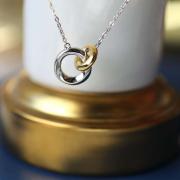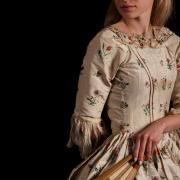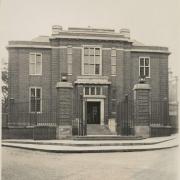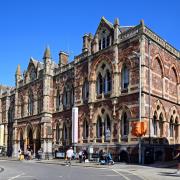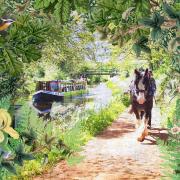The Devon and Exeter Institution (DEI) is one of those wonderful Mediaeval buildings on Cathedral Close that you may have walked past many times without venturing inside - or even realising that it’s open to the public. While not exactly shrouded in mystery, its elegant Georgian facade gives away little. However, its doors are far from closed. Quite the contrary, in fact; two galleried libraries and other public spaces inside are being given a massive makeover to create a place that’s accessible and welcoming to all.
Director Emma Dunn, suitably clad in a high-viz vest, meets me in the lobby to guide me through the construction site and explain the work that’s underway to transform this fascinating building. In September 2021, DEI secured a grant from the National Lottery Heritage Fund to make the building more accessible, carry out essential conservation work and increase its educational and events programme. This funding has been supplemented by donations from members and supporters.

Emma says: 'The Next Chapter is a three-year project to bring this wonderful independent library into the 21st century by removing barriers to access. Like many historic buildings, there’s no wheelchair access, the floors are uneven, there's no lift. We’re putting all of those things in to make it physically accessible.
'We’re also improving intellectual access, by way of explaining our collections better, sharing what we have here and getting the public involved in their interpretation of what we hold so people feel more engaged with our collections. We’re also improving cultural access by diversifying what we offer, letting people know that they can come over the threshold and that the doors are open to welcome people into the Institution.'

Emma adds: 'When we hold our Open Days people often say, “I’ve walked past the door a thousand times, and I didn’t know this was here!” It’s no surprise really because for about 200 years we did operate as quite a closed members’ institution, and there was a slightly opaque process to becoming a member. We’re trying to reverse that perception. Membership is open to all and there are different options for every age and stage. There are currently over 1200 supporters in our community.'
No 7 Cathedral Close has evolved over the centuries and been reinvented and redesigned numerous times by the Courtenay family, since the building was inherited via the marriage of Sir William Courtenay to Margaret Waller in 1643 and used as their town house. It was the Courtenay’s base in the bustling city for more than 150 years until ‘200 Gentlemen of the City’ took ownership. They founded the Institution in 1813 with the lofty aim of promoting 'the general diffusion of Science, Literature and the Arts, and for illustrating the Natural and Civil History of the county of Devon and the History of the City of Exeter.'
This ambition continues to this day.

In 1814 the original double-courtyard layout was adapted and modernised, resulting in two elegant Georgian rooms, one behind the other, which functioned as a library and a museum. By 1820, a Mr Squance was appointed as the Institution’s first live-in librarian. His nephew operated a home-delivery book service for members and, by 1832, the membership had grown to 222 exclusively male proprietors. By 1849, the institution was making headlines - it came in for criticism in the press when Eliza Squance, one of the country’s first female librarians, was appointed following the death of her father. However, women would have to wait four and a half decades until they were allowed to join as members, and a ladies cloakroom was only added in 1908!
Other notable developments in the institution’s history included raising the facade in 1846, connecting the building to the telephone exchange (with an instrument placed in the lavatory!) in 1899, and the appointment in 1931 of a second female librarian, Daphne Drake, who encouraged more women to join.

During the Second World War, the area to the rear was destroyed by bombing and the Institution received £12.13 shillings from the War Damages Commission. The DEI became an Educational Charity in 1989 and the library roof was restored with a grant from the National Lottery Heritage Fund and Historic England in 2016-17 after being placed on the ‘At Risk’ register a few years earlier.
‘The Next Chapter’ promises to deliver a wonderful mix of the old and the new; the front rooms on the ground and first floor are being re-organised and the listed parts of the building are being enhanced with the addition of a modern, partly-glazed extension down one side to literally open up the building and provide all the new services like lifts and loos.

As Emma shows me around, she tells me: 'The ‘welcome’ is really critical for us. We’re putting flagstones on the floor with underfloor heating, which will allow us to have the front doors open more often. The idea is that anyone can come into this space, member or not. In what were previously offices, there will be Reading Rooms and display space.'
It’s a complex renovation process involving heritage building contractors Carrek who are busy removing later additions and subdivisions of rooms to return the front of the Institution to its 1813 layout. On the day I visit, the transformation is most evident on the first floor where a previously subdivided reading room is in the process of being restored to its former glory. The room’s magnificent proportions are enhanced by natural light flooding in from a run of large Georgian windows along one side and a beautifully restored cupola window above.

The work has also revealed earlier colour schemes and previously hidden niches in the walls, discovered by a happy accident when drilling holes to install wall lights. Swatches of various heritage paints are now daubed on the walls to aid decision making on the new decor. Emma is veering towards a shade of bluey-greeney-grey called Celestial Blue for this heavenly southwest-facing room. Without doubt, it has some of the best views in Exeter, straight across the Green towards the Cathedral.
Before too long, the room will be back in use. It’s a perfect multi-purpose space with which to generate income from conferences, exhibitions and public events. An adjacent catering kitchen also opens up the possibility of hosting pop-up foodie events well away from the historic library collections. All in all, there’s an exciting time ahead for this historic library and charity that is now looking firmly to the future.

Emma says: 'We open every Wednesday afternoon for anyone to come along between 1 pm and 4 pm to have a tour and find out about us by talking to volunteers and members of staff. We also run a busy programme of events, many of them free of charge, ranging from high-brow lectures to fun events for children and families. There are all sorts of things that people can get involved in. We hope there’s something for everyone.'
Now I know that there’s also a cinema club and a book group, I’ll definitely be heading back through the double doors to explore what’s on offer. Will you?
devonandexeterinstitution.org






